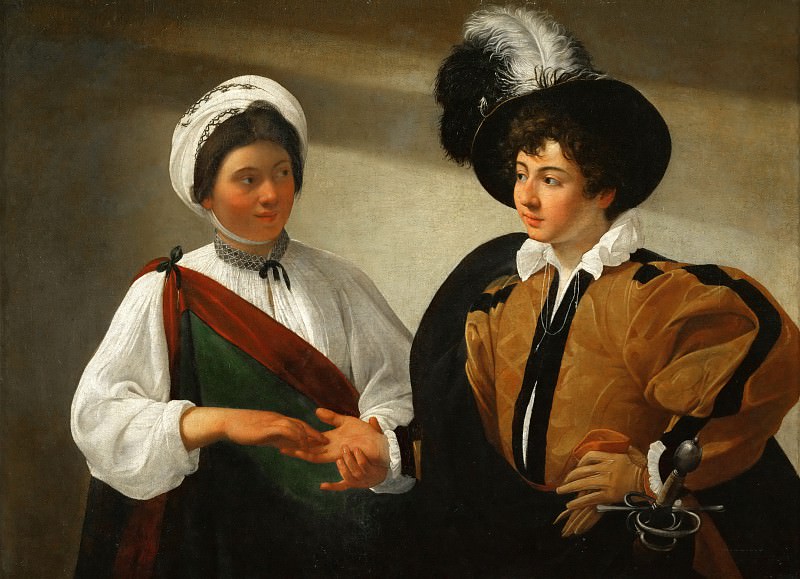Fortune Teller Michelangelo Merisi da Caravaggio (1571-1610)
Michelangelo Merisi da Caravaggio – Fortune Teller
Edit attribution
Download full size: 4451×3219 px (3,4 Mb)
Painter: Michelangelo Merisi da Caravaggio
This painting belongs to the domestic genre and was first mentioned by the artist’s biographers. The canvas depicts a young girl who is a gypsy. A slight smile on her face hides the desire to make a fool of a young man by fortune-telling and telling his future. The hero of the painting comes from a noble family and stares keenly at the pretty girl holding his hand. He seems naïve and interested, waiting with interest for a prediction from the girl.
Description of Caravaggio’s The Fortune Teller (1595)
This painting belongs to the domestic genre and was first mentioned by the artist’s biographers. The canvas depicts a young girl who is a gypsy. A slight smile on her face hides the desire to make a fool of a young man by fortune-telling and telling his future. The hero of the painting comes from a noble family and stares keenly at the pretty girl holding his hand. He seems naïve and interested, waiting with interest for a prediction from the girl. But the young man does not notice that she is about to deceive him.
A surprising detail that is very difficult to notice is the moment of the theft. The gypsy, distracting the boy with her gaze, removes a gold ring from his finger, but he does not see it, not expecting such a trick. The hero of the piece is dressed in a rich dress that speaks of his narcissism. This helps the girl to reveal the mystery of his character and distract him as much as possible from everything that is going on. According to critics, Caravaggio, by painting this picture, wanted to show that plots and events taken from real life can be interesting and carry depth and meaning.
Before creating the painting, the artist invited a young gypsy woman, who had the ability to predict the future, to visit him. He asked her to demonstrate how she could read the hand and tell what was going to happen to a person. The master himself portrayed the person she was to divine to. In this way, he wanted to imbue the moment and experience what was happening as best as possible. Caravaggio’s main goal was to achieve the greatest realism, which is read in the expressions of faces, the behavior of the characters, their clothes and movements. The artist used a sharp contrast of light and shadow, which made his paintings three-dimensional and vivid. His work had a great influence on such artists as Rubens, Velázquez, Rembrandt and others.
Кому понравилось
Пожалуйста, подождите
На эту операцию может потребоваться несколько секунд.
Информация появится в новом окне,
если открытие новых окон не запрещено в настройках вашего браузера.
You need to login
Для работы с коллекциями – пожалуйста, войдите в аккаунт (open in new window).

![Michelangelo Merisi da Caravaggio - Portrait of a Young Man [School]](http://cdn.gallerix.asia/j/C/438722921/6132.webp)


![Michelangelo Merisi da Caravaggio - Young Woman [School of]](http://cdn.gallerix.asia/j/C/438722921/3726.webp)















COMMENTS: 4 Ответы
А в другом месте увас:
"ок1594. 115x150. Капитолийcкий музей, Рим"
http://gallerix.ru/storeroom/438722921/N/3876/
А в другом месте у нас другая картина ;)
Какое великолепие!!
Скажи мне, гадалка, что ждет меня завтра,
И что мне кудесница-жизнь принесет,
В пучину какого шального азарта
Меня ураганом любви занесет?
You cannot comment Why?
This painting depicts a scene where a young woman, dressed in a white blouse and a colorful sash, is examining the hand of a young man. The man, wearing an elaborate hat adorned with feathers and rich attire, looks towards the woman with a somewhat naive expression.
Subtexts and Interpretations:
Deception and Naivety: The title, Fortune Teller, immediately suggests a theme of deception. The woman is likely not a genuine fortune teller but a cunning figure preying on the mans innocence or perhaps his vanity and desire to know the future. Her engaging gaze and the gesture of holding his hand imply a performance designed to impress and possibly swindle him. The mans youthful appearance and unfocused gaze suggest a lack of worldliness, making him an easy target.
Social Commentary: The painting can serve as a commentary on social interactions and the ease with which people can be taken advantage of, particularly when seeking guidance or entertainment from those perceived as possessing special knowledge. It highlights the contrast between shrewdness (the woman) and gullibility (the man).
Theatricality and Illusion: The mans attire, particularly his feathered hat and the rapier at his side, suggests a certain social standing or perhaps a theatrical persona. This adds to the sense that the encounter is a staged event, with the woman playing her part to extract something from the man, be it money or something more fleeting. The lighting, casting a subtle shadow, further enhances the dramatic and perhaps clandestine nature of the interaction.
Human Vulnerability: Beyond the immediate scene of a con, the painting touches upon broader human themes of curiosity, hope, and the desire for certainty in a world that is often unpredictable. The mans willingness to have his fortune told speaks to these fundamental human needs.
In essence, the painting captures a moment of subtle trickery, where an experienced deceiver engages with an unsuspecting victim, offering a glimpse into the timeless dynamics of human interaction, trust, and manipulation.